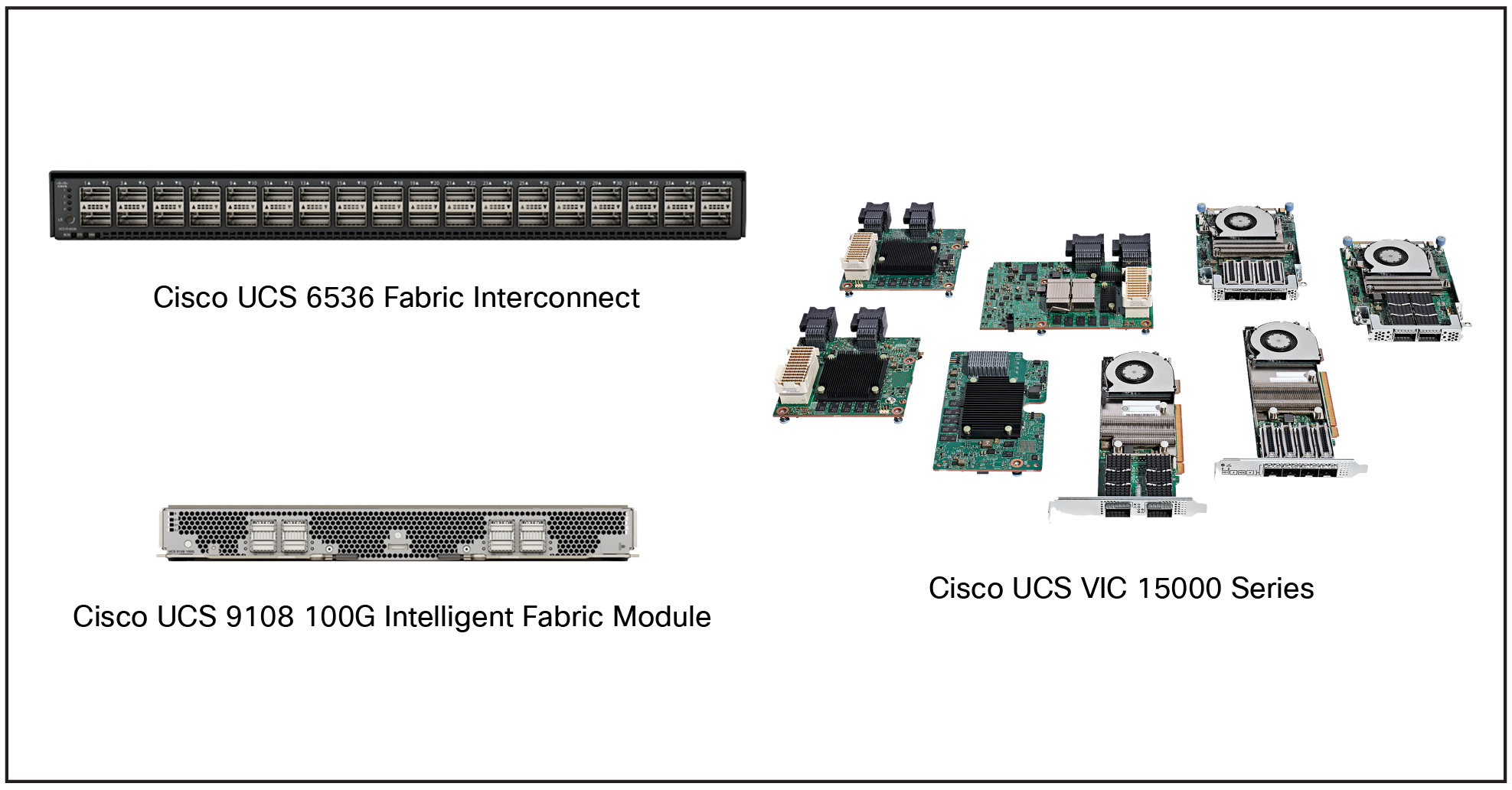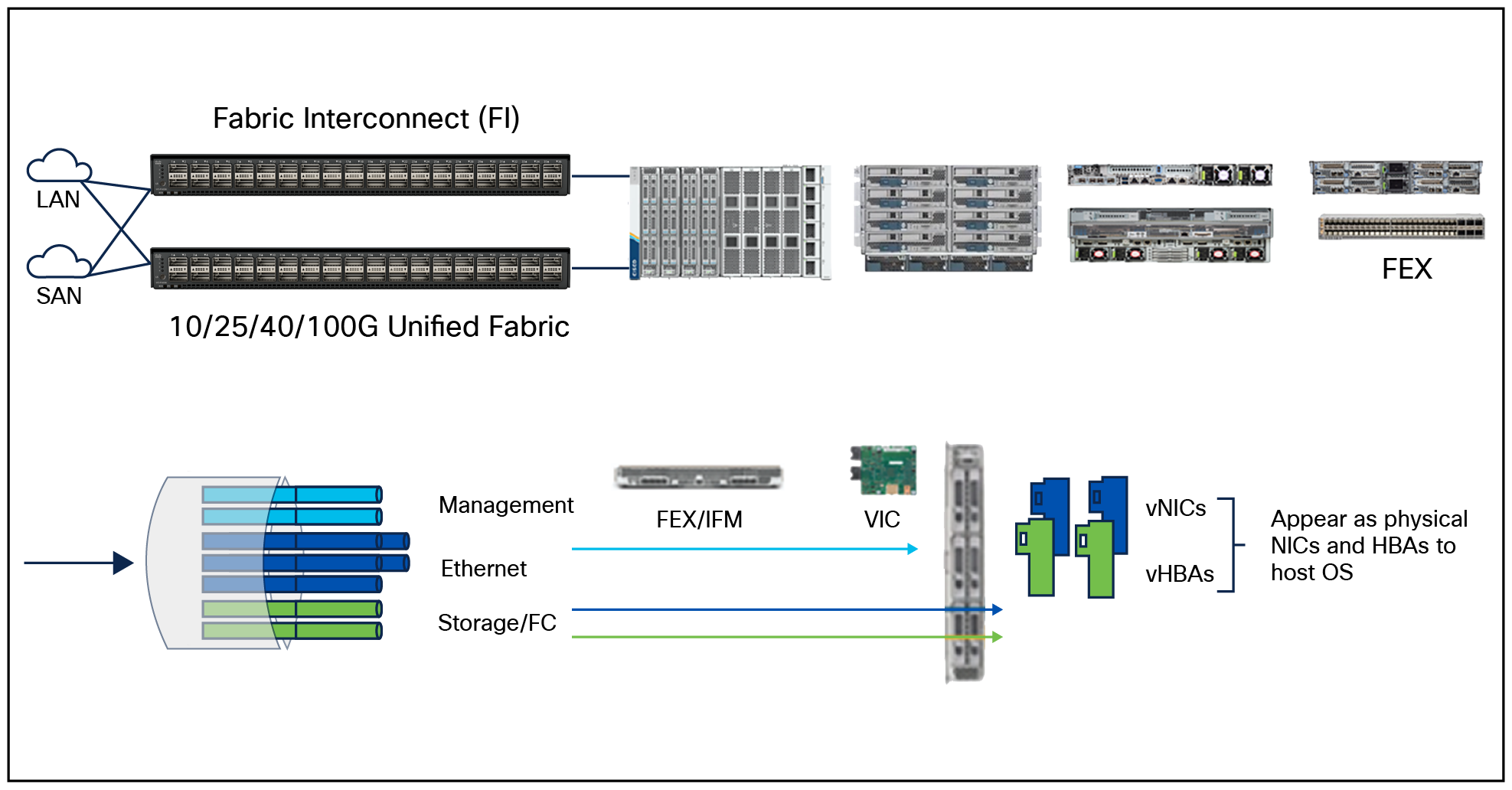Cisco UCS 5th Generation Unified Fabric At-a-Glance
Available Languages
Bias-Free Language
The documentation set for this product strives to use bias-free language. For the purposes of this documentation set, bias-free is defined as language that does not imply discrimination based on age, disability, gender, racial identity, ethnic identity, sexual orientation, socioeconomic status, and intersectionality. Exceptions may be present in the documentation due to language that is hardcoded in the user interfaces of the product software, language used based on RFP documentation, or language that is used by a referenced third-party product. Learn more about how Cisco is using Inclusive Language.
As the demand for higher bandwidth from applications continues to increase, server workloads often face limitations in available compute fabric bandwidth. This need for increased bandwidth is further amplified by the rapidly evolving landscape of compute technologies such as PCIe generation upgrades, higher-core CPU refreshes, dense server virtualizations, cloud-native applications, newer IP storage protocols, increased data backups, GPUs, and innovations such as Compute Express Link (CXL). To meet these growing demands, data centers need a compute fabric that can seamlessly scale compute bandwidth without adding complexity, while ensuring guaranteed services for diverse applications at 100G speeds.
Enter the Cisco UCS 5th Generation Fabric, designed from the ground up to simplify, scale up, consolidate, and deliver end-to-end virtualization with guaranteed bandwidth for different classes of traffic in the data center. The Cisco UCS 5th Generation Fabric consolidates LAN and SAN traffic onto a single unified fabric, resulting in cost savings in both Capital expenditures (CapEx) and Operating expenses (OpEx) compared to traditional compute network architectures that require multiple parallel networks, different adapter cards, switching infrastructure, and complex cabling within racks. As compute connectivity transitions from 10G/25G/40G to 100G in data-center networks, the Cisco UCS 5th Generation Fabric provides 100G end-to-end bandwidth for compute nodes across Ethernet, Fibre Channel, and IP storage traffic, enabling scalable application performance in data centers.
The Cisco UCS 5th Generation Fabric is composed of the Cisco UCS 6536 Fabric Interconnect (FI), Cisco UCS 9108 100G Intelligent Fabric Module (X9108-IFM-100G), and the 200G Cisco UCS 15000 Series Virtual Interface Cards (VICs). These components collectively deliver a switching capacity of 7.42 Tbps per Fabric Interconnect, 14.84 Tbps per unified fabric domain, and 1.6 Tbps non-oversubscribed bandwidth per Cisco UCS X9508 Chassis with end-to-end 100G Ethernet and 200G bandwidth per Cisco UCS X-Series compute node or Cisco UCS C-Series rack server, unleashing the next level of computing innovation in data centers with the Cisco UCS 5th Generation Fabric.

Cisco UCS 5th Generation Fabric
The Cisco UCS 6536 Fabric Interconnect supports I/O consolidation with end-to-end network virtualization, visibility, and Quality-of-Service (QoS) guarantees for the following LAN and SAN traffic:
● LAN traffic and server management.
● Traditional storage traffic (FC SAN, iSCSI, NFS).
● NVME-over-Fabric (NVMe/FC, NVMe/TCP, NVMe over ROCEv2).
The I/O consolidation under the Cisco UCS 6536 Fabric Interconnect along with the stateless policy-driven architecture of Cisco UCS and the hardware acceleration of the Cisco UCS VIC provides operational simplicity, flexibility, resiliency, performance, and TCO savings for the customer’s compute infrastructure.

Cisco UCS 5th Generation Unified Fabric
● Greater I/O consolidation with 100G fabric resulting in fewer cables, adapters, and switches for compute connectivity.
● Simplified cabling, feature-richness, and policy-driven and cloud-operated management of compute infrastructure at scale with high operational resiliency, while lowering the TCO of the data center.
● Flexibility in connectivity with 1G/10G/25G/40G/100G Ethernet speeds.
● End-to-end 100G Ethernet traffic support across management, Ethernet, and IP storage traffic.
● End-to-end 32G Fibre Channel single I/O support and 100G Fibre Channel bandwidth per fabric for a
X-Series and C-Series servers.
● CapEx savings with fewer and faster cables and adapters, and I/O consolidation reducing needed switching infrastructure.
● OpEx savings with simplified operations, the highest density of server management under a single switching domain, and a reduction in network power needs for a sustainable fabric.
Cisco UCS 6536 Fabric interconnect with 36x 100-Gbps ports.
Choice of fabric extenders and intelligent fabric modules for X-Series, B-Series, and C-Series servers.
● Cisco UCS 9108 100G Intelligent Fabric Module.
● Cisco UCS 9108 25G Intelligent Fabric Module.
● Cisco UCS 2408 Fabric Extender.
● Cisco UCS 2304 Fabric Extender.
● Cisco Nexus® 93180YC-FX3 in FEX mode.
Choice of various Cisco UCS 15000 Series VICs.
● mLOM, mezzanine, and PCIe VIC cards for UCS M6/M7 B-, C-, and X- Series.
Choice of Cisco UCS management using Cisco Intersight™ or Cisco UCS Manager (UCSM).
Cisco UCS 6536 Fabric interconnect also supports Cisco VIC 1300 series and Cisco VIC 1400/14000 series with Cisco UCS M4/M5/M6 servers in UCS Manager and Intersight.
For more information on Cisco UCS 5th Generation Unified Fabric, visit https://www.cisco.com/c/en/us/products/servers-unified-computing/fabric-interconnects.html.